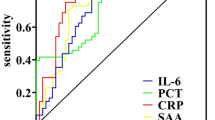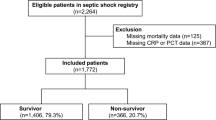Abstract
Objective:
The purpose of this study was to determine the role of serum amyloid A (SAA) in diagnosis of neonatal sepsis and evaluation of clinical response to antibiotic therapy. We also aimed to compare the efficiency of SAA with that of C-reactive protein (CRP) and procalcitonin (PCT) in diagnosis and follow-up of neonatal sepsis in preterm infants.
Study Design:
A total of 163 infants were enrolled in this prospective study. The infants were classified into four groups: group 1 (high probable sepsis), group 2 (probable sepsis), group 3 (possible sepsis) and group 4 (no sepsis, control group). Blood samples for whole blood count, CRP, PCT, SAA and culture were obtained before initiating antibiotic treatment. This procedure was repeated three times at 48 h, 7 and 10 days.
Result:
Initial CRP, PCT and SAA levels were found to be positive in 73.2, 75.6 and 77.2% of all infants, respectively. Sensitivities of CRP, PCT and SAA at 0 h were 72.3, 74.8 and 76.4%, respectively. Although it was not statistically significant, SAA was found to be more sensitive than CRP and PCT in diagnosis of neonatal sepsis. The area under the curve (AUC) for CRP, PCT and SAA at 0 h were 0.870, 0.870 and 0.875, respectively. Although the AUC for SAA at 0 h was higher than PCT and CRP, the difference was not statistically significant.
Conclusion:
SAA is an accurate and reliable marker for diagnosis and follow-up of neonatal sepsis. It is especially useful at the onset of inflammation for rapid diagnosis of neonatal sepsis and can be safely and accurately used in combination with other sepsis markers such as CRP and PCT in diagnosis and follow-up of neonatal sepsis in preterm infants.
This is a preview of subscription content, access via your institution
Access options
Subscribe to this journal
Receive 12 print issues and online access
$259.00 per year
only $21.58 per issue
Buy this article
- Purchase on Springer Link
- Instant access to full article PDF
Prices may be subject to local taxes which are calculated during checkout



Similar content being viewed by others
References
Ng PC, Lam HS . Diagnostic markers for neonatal sepsis. Curr Opin Pediatr 2006; 18: 125–131.
Ng PC . Clinical trials for evaluating diagnostic markers of infection in neonates. Biol Neonate 2005; 87: 111–112.
Pızzını C, Mussap M, Plebanı M, Fanos V . C-reactive protein and serum amyloid a protein in neonatal infections. Scand J Infect Dis 2000; 32: 229–235.
Remington JS, Klein JO . Infectious Diseases of the Fetus and Newborn Infant. WB Saunders Company: Philadelphia, 2001, pp 943–985.
Chiesa C, Panero A, Rossi N, Stegagno M . Reliability of procalcitonin concentrations for the diagnosis of sepsis in critically ill neonates. Clin Infect Dis 1998; 26: 664–672.
Folli HL, Poole RL, Benitz WE, Russo JC . Medication error prevention by clinical pharmacist in two pediatric hospitals. Pediatrics 1987; 79: 718–722.
Philip AG, Hewitt JR . Early diagnosis of neonatal sepsis. Pediatrics 1980; 65: 1036–1041.
Rodwell RL, Leslie AL, Tudehope DI . Early diagnosis of neonatal sepsis using a hematological scoring system. J Pediatr 1988; 112: 761–767.
Laurenti F, Fassi F, Campi E, Ceri E, Ligi L, Donato AI et al. Origine e significato delle proteine ‘maggiori’ della fase acuta. Aggiornamenti in Neonatologia 1996; 4: 173–193.
Arnon S, Litmanovitz I, Regev RH, Bauer S, Shainkin-Kestenbaum R, Dolfin T . Serum amyloid A: an early and accurate marker of neonatal early-onset sepsis. J Perinatol 2007; 5: 297–302.
Arnon S, Litmanovitz I, Regev R, Bauer S, Lis M, Sha R . Serum amyloid a protein is a useful inflammatory marker during late-onset sepsis. Biol Neonate 2005; 87: 105–110.
Arnon S, Litmanovitz I . Diagnostic tests in neonatal sepsis. Curr Opin Infect Dis 2008; 21: 223–227.
Whicher J, Bienvenu J, Monneret G . Procalcitonin as an acute phase marker. Ann Clin Biochem 2001; 38: 483–493.
Dandona P, Nix D, Wilson MF, Aljada A, Love J, Assicot M et al. Procalcitonin increase after endotoxin injection in normal subjects. J Clin Endocrinol Metab 1994; 79: 1605–1608.
Assicot M, Gendrel D, Carsin H, Raymond J, Guilbaud J, Bohuon C . High serum procalcitonin concentrations in patients with sepsis and infection. Lancet 1993; 341: 515–518.
Ghillani PP, Motté P, Troalen F, Jullienne A, Gardet P, Le Chevalier T et al. Identification and measurement of calcitonin precursors in serum of patients with malignant diseases. Cancer Res 1989; 49: 6845–6851.
Gitto E, Karbownik M, Reiter RJ, Tan DX, Cuzzocrea S, Chiurazzi P et al. Effects of melatonin treatment in septic newborns. Pediatr Res 2001; 50: 756–760.
Manroe BL, Weinberg AG, Rosenfeld CR, Browne R . The neonatal blood count in health and disease. I. Reference values for neutrophilic cells. J Pediatr 1979; 95: 89–98.
Rodwell RL, Leslie AL, Tudehope DI . Early diagnosis of neonatal sepsis using a hematological scoring system. J Pediatr 1988; 112: 761–767.
Ng PC, Cheng SH, Chui KM, Fok TF, Wong MY, Wong W et al. Diagnosis of late onset neonatal sepsis with cytokines, adhesion molecule, and C-reactive protein in preterm very low birthweight infants. Arch Dis Child 1997; 77: 221–227.
Ng PC . Diagnostic markers of infection in neonates. Arch Dis Child Fetal Neonatal Ed 2004; 89: 229–235.
Enguix A, Rey C, Concha A, Medina A, Coto D, Dieguez MA . Comparison of procalcitonin with C-reactive protein and serum amyloid for the early diagnosis of bacterial sepsis in critically ill neonates and children. Intensive Care Med 2001; 27: 211–215.
Couto RC, Barbosa JA, Pedrosa TM, Biscione FM . C-reactive protein-guided approach may shorten length of antimicrobial treatment of culture-proven late-onset sepsis: an intervention study. Braz J Infect Dis 2007; 11: 240–245.
Chiesa C, Pacifico L, Rossi N, Panero A, Matrunola M, Mancuso G . Procalcitonin as a marker of nosocomial infections in the neonatal intensive care unit. Intensive Care Med 2000; 26: 175–177.
Köksal N, Harmanci R, Cetinkaya M, Hacimustafaoğlu M . Role of procalcitonin and CRP in diagnosis and follow-up of neonatal sepsis. Turk J Pediatr 2007; 49: 21–29.
Hatherill M, Tibby SM, Sykes K, Turner C, Murdoch IA . Diagnostic marker of infection: comparison of procalcitonin with C-reactive protein and leucocyte count. Arch Dis Child 1999; 81: 417–421.
Prat C, Domínguez J, Rodrigo C, Giménez M, Azuara M, Blanco S et al. Use of quantitative and semiquantitative procalcitonin measurement to identify children with sepsis and meningitis. Eur J Clin Microbiol Infect Dis 2004; 23: 136–138.
Lapillonne A, Basson E, Monneret G, Bienvenu J, Salle BL . Lack of specificity of procalcitonin for sepsis diagnosis in premature infants. Lancet 1998; 351: 1211–1212.
Janota J, Stranak Z, Belohlavkova S, Mudra K, Simak J . Postnatal increase of procalcitonin in premature newborns is enhanced by chorioamnionitis and neonatal sepsis. Eur J Clin Invest 2001; 31: 978–983.
Arnon S, Litmanovitz I, Regev R, Lis M, Shainkin-Kestenbaum R, Dolfin T . Serum amyloid A protein in the early detection of late-onset bacterial sepsis in preterm infants. J Perinat Med 2002; 30: 329–332.
Arnon S, Litmanovitz I, Regev R, Lis M, Shainkin-Kestenbaum R, Dolfin T . The prognostic virtue of inflammatory markers during late-onset sepsis in preterm infants. J Perinat Med 2004; 32: 176–180.
Shortland DB, MacFayden U, Elston A, Harrison G . Evaluation of C-reactive protein values in neonatal sepsis. J Perinat Med 1990; 18: 157–163.
Author information
Authors and Affiliations
Corresponding author
Rights and permissions
About this article
Cite this article
Çetinkaya, M., Özkan, H., Köksal, N. et al. Comparison of serum amyloid A concentrations with those of C-reactive protein and procalcitonin in diagnosis and follow-up of neonatal sepsis in premature infants. J Perinatol 29, 225–231 (2009). https://doi.org/10.1038/jp.2008.207
Received:
Revised:
Accepted:
Published:
Issue Date:
DOI: https://doi.org/10.1038/jp.2008.207
Keywords
This article is cited by
-
Point-of-Care Serum Amyloid A as a Diagnostic Marker for Neonatal Sepsis
Indian Journal of Pediatrics (2023)
-
Diagnosis of neonatal sepsis: the past, present and future
Pediatric Research (2022)
-
Procalcitonin versus C-reactive protein: review of kinetics and performance for diagnosis of neonatal sepsis
Journal of Perinatology (2019)
-
The combination of procalcitonin and C-reactive protein or presepsin alone improves the accuracy of diagnosis of neonatal sepsis: a meta-analysis and systematic review
Critical Care (2018)
-
Impact of sepsis on the urinary level of interleukin-18 and cystatin C in critically ill neonates
Pediatric Nephrology (2013)



